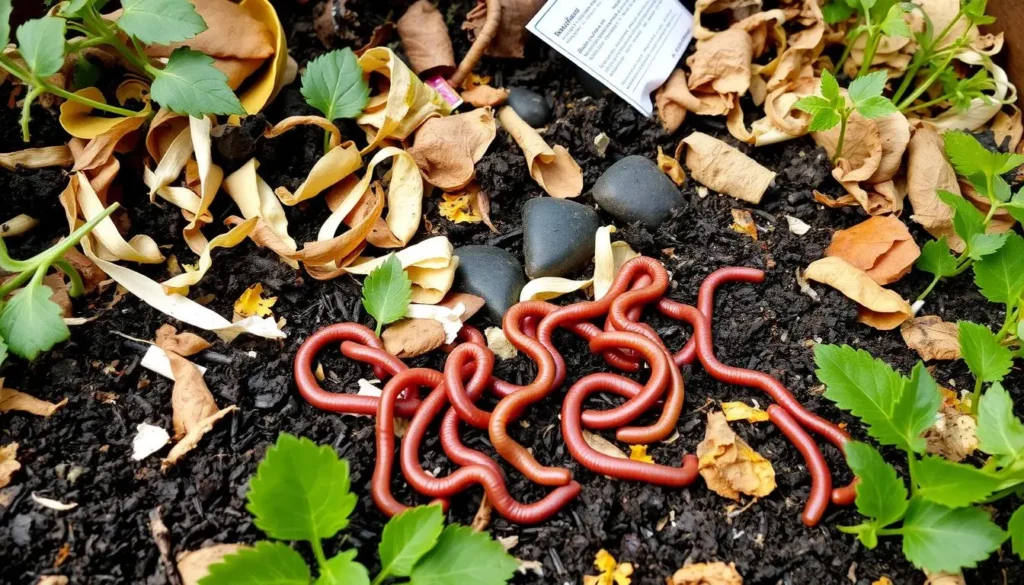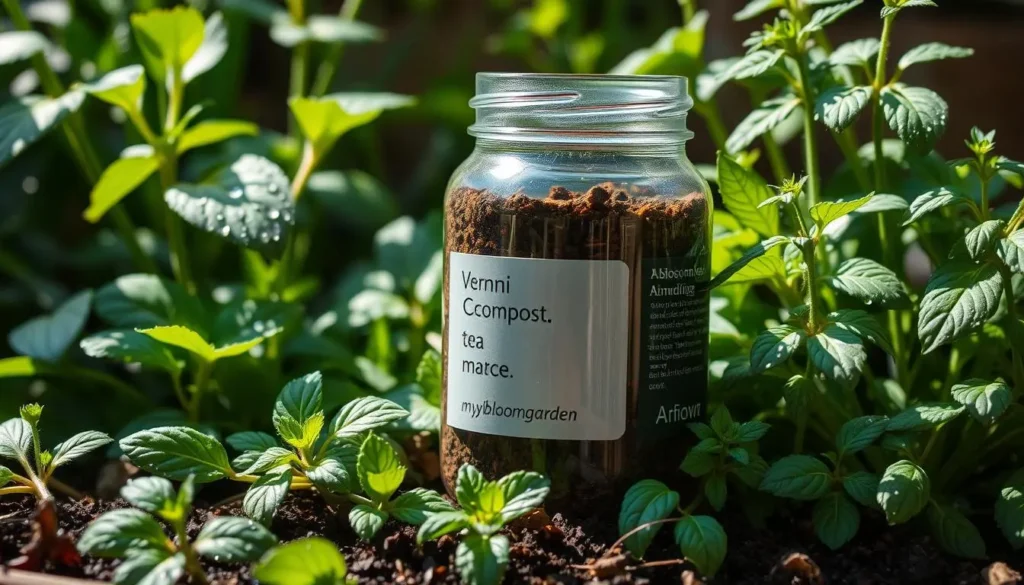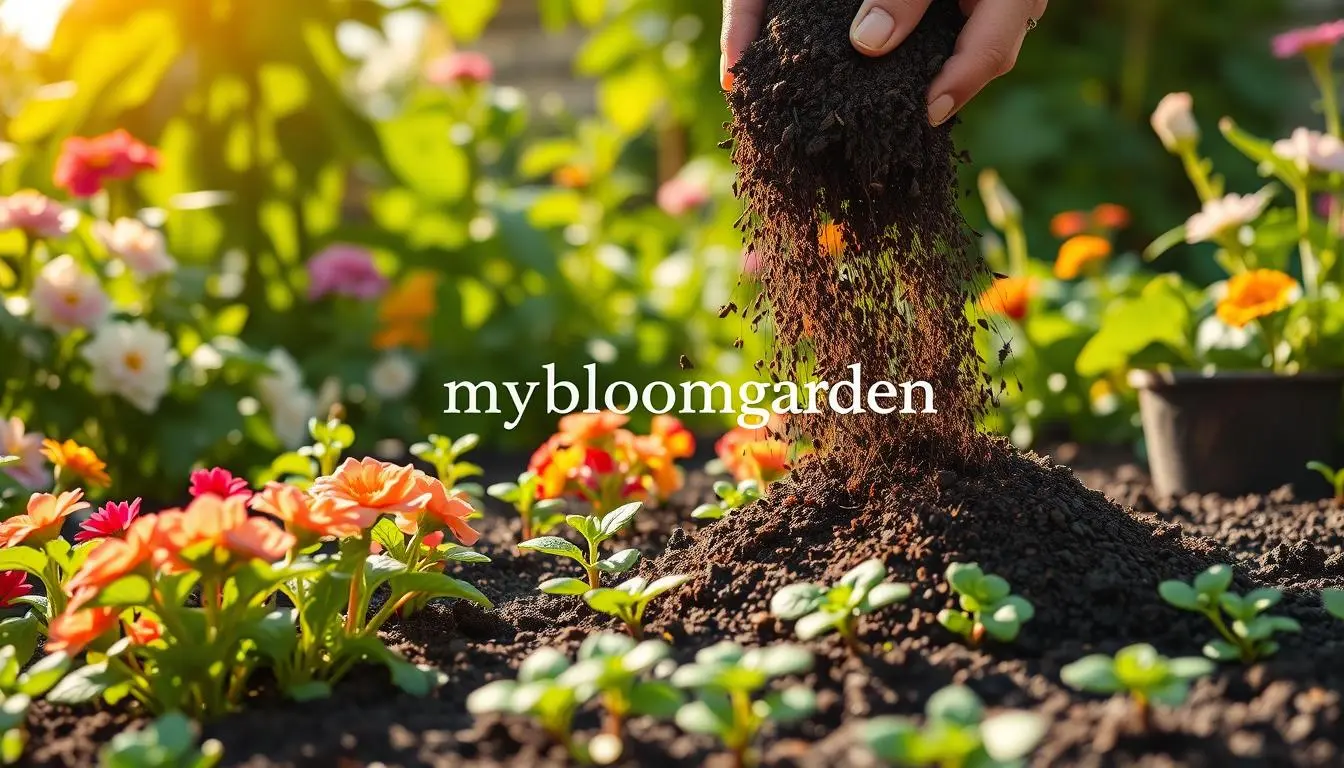I love gardening and always wanted my plants to grow well. But, using regular fertilizers didn’t feel right for me or the planet. That changed when I learned about vermicomposting.
Vermicomposting uses worms to turn waste into a special soil food. It’s amazing for your plants. It makes them grow strong and healthy, better than any chemical fertilizer.
Table of Contents
Understanding the Basics of Vermicomposting
Diving into vermicomposting, or vermiposting, opens up a world of benefits for your garden. It uses special worms, called vermicomposters, to turn organic waste into a rich soil amendment.
The Science Behind Worm Composting
The science of vermicomposting is both fascinating and effective. Worms eat organic materials and break them down in their digestive system. This turns them into a compost that’s full of nutrients, great for your plants.
This process not only cuts down on waste but also makes a natural fertilizer. Your plants will love it.
Types of Composting Worms
Choosing the right worms for vermicomposting is key. The red wiggler (Eisenia fetida) and the European nightcrawler (Eisenia hortensis) are top picks. They eat a lot and can handle many types of organic materials well.
Essential Components of a Vermicompost System
- Bedding: A good bedding, like shredded newspaper or coconut coir, keeps worms comfy and the right moisture level.
- Food Scraps: Worms love eating organic stuff like fruit and veggie scraps, coffee grounds, and shredded paper.
- Moisture Control: It’s important to keep the moisture just right. Worms need it damp but not too wet.
Learning about vermicomposting helps you set up a system that’s good for your plants and the planet.
Benefits of Vermicompost for Plants
Adding vermicompost to your garden can greatly benefit your plants. This material, made by composting worms, is full of nutrients. It helps plants grow strong and produce more.
Vermicompost makes the soil better. It adds organic matter and microbes. This helps plants absorb water and nutrients better. Your plants will grow strong and healthy.
- Increased nutrient availability: Vermicompost is full of nutrients like nitrogen, phosphorus, and potassium. These are good for your plants’ growth.
- Improved water retention: Vermicompost helps the soil keep water. This means you don’t have to water as often. Your plants stay hydrated.
- Natural pest resistance: Vermicompost has natural pest fighters. This means you can avoid harsh chemicals. Your garden will be healthier.
Using vermicompost can change your garden for the better. It’s great for vegetables, flowers, or any plants. With vermicompost, your garden will flourish.
“Vermicompost is a true garden elixir, nourishing both the soil and the plants that call it home.”
Setting Up Your Vermicomposting Bin
Starting your vermi-composting journey? First, set up your own vermicomposting bin. This system turns food scraps into compost, great for your plants. Let’s explore how to create the best vermicomposting setup.
Choosing the Right Container
The container is key in vermi-composting. Choose a sturdy, well-ventilated bin, often made of plastic or wood. It should match the size of your waste. Aim for 1 square foot of space per pound of waste per week.
Creating the Perfect Bedding
Worms love a moist, cozy place. Mix shredded newspaper, cardboard, or coconut coir for bedding. It’s comfy for worms and keeps the bin moist.
Optimal Environmental Conditions
Worms like temperatures between 55°F and 77°F. Place your bin in a cool, shaded spot, away from sunlight. Keep the bedding damp, like a wrung-out sponge, to maintain moisture.
Follow these tips to create a great home for your worms. This will start a successful vermi-composting journey. Soon, you’ll turn waste into valuable compost for your garden.
What Materials to Use in Vermicomposting
Vermicomposting uses worms to turn waste into soil that’s full of nutrients. It’s important to know which materials work well and which don’t.
Worms need a mix of “green” and “brown” materials to thrive. Green materials are things like fruit and veggie scraps, coffee grounds, and fresh plant cuttings. Brown materials include shredded paper, cardboard, and dried leaves.
- Fruit and vegetable scraps give worms the nutrients they need.
- Coffee grounds add nitrogen and help keep the right pH.
- Shredded paper and cardboard help with structure and air in the bin.
But, some things shouldn’t go into vermicomposting. Meat, dairy, and oily foods can attract pests and smell bad. Also, too much citrus can mess with the worms’ pH.
“The key to successful vermicomposting is finding the right balance between green and brown materials to create a thriving environment for the worms.”
Choosing the right materials carefully helps gardeners make a nutrient-rich compost. This compost will feed plants and improve the soil.

Maintaining Your Vermicompost System
Keeping your vermiposting system healthy is key to making great vermicomposters for your plants. By following some easy steps, your worm bin will stay active and productive.
Proper Feeding Schedule
It’s important to feed your worms the right amount of food at the right time. Experts say to give them a bit of food waste every few days. This keeps the bin balanced in moisture and oxygen.
Moisture and Temperature Control
Worms like a moist but not soggy place. Check the moisture of your vermicomposters often. Add water or dry bedding as needed to keep it just right. Also, keep the temperature between 55-77°F for best worm activity.
Common Problems and Solutions
- Odors: If you smell something strong, it might mean too much moisture or too much food. Adjust your feeding and add more bedding to fix it.
- Pests: To keep pests away, keep your bin clean and cover food waste well.
- Slow Decomposition: If things are moving slow, try making food scraps more exposed or add different bedding to get worms going again.
By following these tips, you can keep your vermiposting system running well. This means you’ll always have nutrient-rich vermicomposters to feed your plants and improve your soil.
“Vermicomposting is a fantastic way to transform your food waste into a valuable soil amendment for your garden. With a little care and attention, your worm bin can become a thriving ecosystem that benefits your plants and the environment.”
Harvesting and Storing Your Vermicompost
Getting your vermicompost right is key to boosting your plants’ growth. There are a few important steps to follow to get the best results from your vermi-composting.
Harvesting Vermicompost
The perfect time to harvest your vermicompost is when the bedding is fully broken down. This usually takes 3-6 months, depending on the temperature and how often you feed the worms. To harvest, shine a bright light on the bin. This will make the worms move down, and you can scoop up the vermicompost from the top.
Another good way is the tray system. You stack trays on top of each other. As worms move up for food, you can take out the bottom tray. It will have the finished vermicompost.
Storing Vermicompost
After harvesting, it’s crucial to store your vermicompost correctly. Keep it in a cool, dry spot like a basement or shed. Use a breathable container, like a burlap sack or mesh bag. Don’t use airtight containers, as they can cause bad smells and harm the compost.
With the right harvesting and storage, your vermicompost will stay a strong fertilizer for your plants. It will help them grow well and reach their full potential.
How to Apply Vermicompost for Plants
Vermicompost is a rich, organic fertilizer that can greatly benefit your plants. If you’ve been tending to your vermicompost system, it’s time to learn how to use it. We’ll cover application rates, the best times to apply, and different methods.
Application Rates for Different Plant Types
The amount of vermicompost needed varies by plant type. Here’s a basic guide:
- Vegetables and annual flowers: Mix 1-2 inches of vermicompost into the soil before planting.
- Perennial plants and shrubs: Apply 2-4 inches of vermicompost as a top dressing around the plant base.
- Houseplants and container gardens: Use 1 part vermicompost to 2-3 parts potting mix when repotting.
Best Seasonal Timing for Application
The ideal time to apply vermicompost depends on your climate and growing season. Generally:
- Spring: Use vermicompost to enrich the soil before planting your garden.
- Summer: Top dress established plants with a thin layer of vermicompost for a nutrient boost.
- Fall: Mix vermicompost into the soil to prepare for the next growing season.
Methods of Application
There are several ways to add vermicompost to your garden and landscape:
- Top dressing: Spread a 1-2 inch layer of vermicompost over the soil surface and gently work it in.
- Soil amendment: Mix vermicompost into the top 6-8 inches of soil before planting.
- Potting mix: Blend vermicompost into your potting mix when repotting houseplants or container gardens.
- Compost tea: Steep vermicompost in water to create a nutrient-rich liquid fertilizer for plants.
Regardless of the method, make sure to mix the vermicompost well into the soil or potting mix. This ensures your plants get the most benefits.
Making Vermicompost Tea and Extracts
Take your gardening to the next level with vermicompost tea and extracts. These liquid fertilizers come from the vermicomposting process. They give your plants a big boost. Use them for foliar feeding or as a soil drench to see amazing results.
Crafting Vermicompost Tea
Making vermicompost tea is easy and rewarding. You’ll need a burlap sack or mesh bag, a large container, and water. Fill the bag with your vermicomposting material and soak it in water for 24-48 hours. This makes a tea full of nutrients for your plants.
Brewing Vermicompost Extracts
For a stronger plant elixir, try vermicompost extracts. Mix worm castings with water and let it steep. This creates a concentrated fertilizer. It’s great for a soil drench, giving your plants a direct nutrient boost.
“Vermicompost tea and extracts are like liquid gold for your plants, providing a targeted boost of nutrients and beneficial microbes.”
Whether you choose tea or extracts, they’re a big win for your garden. Add them to your routine and watch your plants grow stronger and healthier.

- Vermicompost tea: A nutrient-rich liquid fertilizer made by steeping worm castings in water
- Vermicompost extracts: A concentrated liquid fertilizer created by extracting the nutrients from worm castings
- Both offer a concentrated dose of essential plant-supporting compounds for foliar feeding and soil drenching
Troubleshooting Common Vermicomposting Issues
Keeping a vermicomposting system running smoothly can be tough. You might face issues like pests, odors, and keeping worms healthy. But don’t worry, with the right steps, you can tackle these problems and keep your worms happy.
Pest Management
Pests like fruit flies or mites can sneak into your bin. To stop them, make sure your bin is tightly sealed. You can also cover it with mesh or burlap to keep flies out. Keep an eye on your bin and act fast to keep pests away.
Odor Control
Bad smells can happen if your bin isn’t just right. To avoid this, keep the right moisture and air flow. Don’t overfeed your worms, and make sure food is fully buried. If smells still bother you, try changing the bedding or adding more carbon-rich materials.
Population Management
It’s important to keep your worm population balanced. Watch how many worms you have and adjust as needed. If there are too many, you can harvest some for new bins or share them. If there aren’t enough, add more food and bedding.
By tackling these common issues, you can keep your vermicomposters working well. Your vermiposting journey will stay rewarding. With a bit of troubleshooting and care, your system will provide great soil for your plants.
Conclusion
Discovering vermicompost for plants can change your gardening game. It’s a natural, nutrient-rich soil amendment. It boosts soil health, plant growth, and resilience.
By starting vermicomposting, you nourish your plants and help the environment. This makes your garden practice more sustainable and eco-friendly.
This article covered worm composting’s science, vermicompost system parts, and its benefits. Vermicompost improves water retention, soil structure, and nutrient supply. It’s a reliable solution for gardeners wanting healthy plants.
We suggest adding vermicomposting to your gardening routine. It helps houseplants, vegetable gardens, and flower beds. Vermicompost can greatly improve your plants’ health and vitality.
Try this sustainable practice and see vermicompost’s power. It’s nature’s own growth booster.

